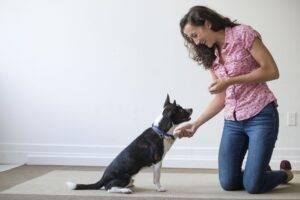
Are you looking to build a strong, loving bond with your furry friend while fostering good behavior? Positive reinforcement training is the key, and the use of training aids can take your dog’s training to new heights. In this article, we’ll explore how to harness the power of positive reinforcement and various training aids to ensure your dog is not just well-behaved but also radiantly happy.
1. Treats: The Ultimate Motivators
Treats are a cornerstone of positive reinforcement training. They serve as immediate rewards for your dog’s desired behaviors, making them eager to learn. Opt for tasty, bite-sized treats that your dog adores and reserve them exclusively for training sessions. The joy of earning treats will motivate your pup to excel in their training.
2. Clickers: Timing Is Everything
Clickers are small devices that make a distinct clicking sound. They’re invaluable for marking the exact moment your dog exhibits the behavior you want. The click serves as a clear signal that a reward is coming, providing precise feedback to your pup. With practice, your dog will learn to associate the click with positive outcomes, expediting the learning process.
3. Toys: Playful Rewards
Toys can be just as rewarding as treats, especially for playful pups. When your dog performs a desired action, engage them in a quick game of fetch or tug-of-war with their favorite toy. The sheer joy of play can be a potent motivator.
4. Praise and Affection: The Power of Love
Never underestimate the power of your love and affection. Shower your dog with praise, cuddles, and encouraging words during and after training sessions. Your enthusiasm and positive energy will reinforce their good behavior and strengthen your bond.
5. Consistency and Patience: The Human Element
Remember that consistency and patience are essential. Positive reinforcement training takes time, and it’s crucial to maintain a calm and patient demeanor. Avoid frustration, and always end training sessions on a positive note.
6. Routine and Structure: Set the Stage
Establish a routine for training sessions to create a structured environment for your dog. Consistent timing and a familiar training space help your pup focus and feel comfortable during training.
7. Variability: Keep It Interesting
Keep training interesting by varying the exercises and the location. This prevents boredom and helps your dog generalize their training to different situations.
In a nutshell, positive reinforcement training aids, when used effectively, can turn your dog into a happy, well-behaved, and eager learner. Whether you’re using treats as ultimate motivators, clickers for precise timing, toys for playful rewards, praise and affection for the power of love, consistency and patience as the human element, routine and structure to set the stage, or variability to keep it interesting, these tools can make training an enjoyable and rewarding experience for both you and your beloved furry friend. So, embark on this pawsitive journey, and watch your dog flourish into the well-behaved companion you’ve always dreamed of!